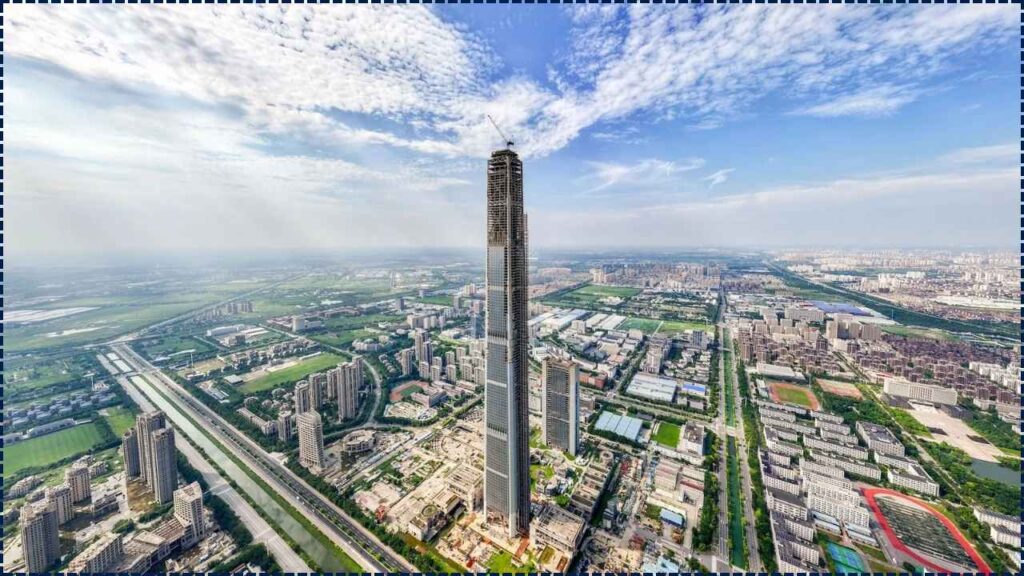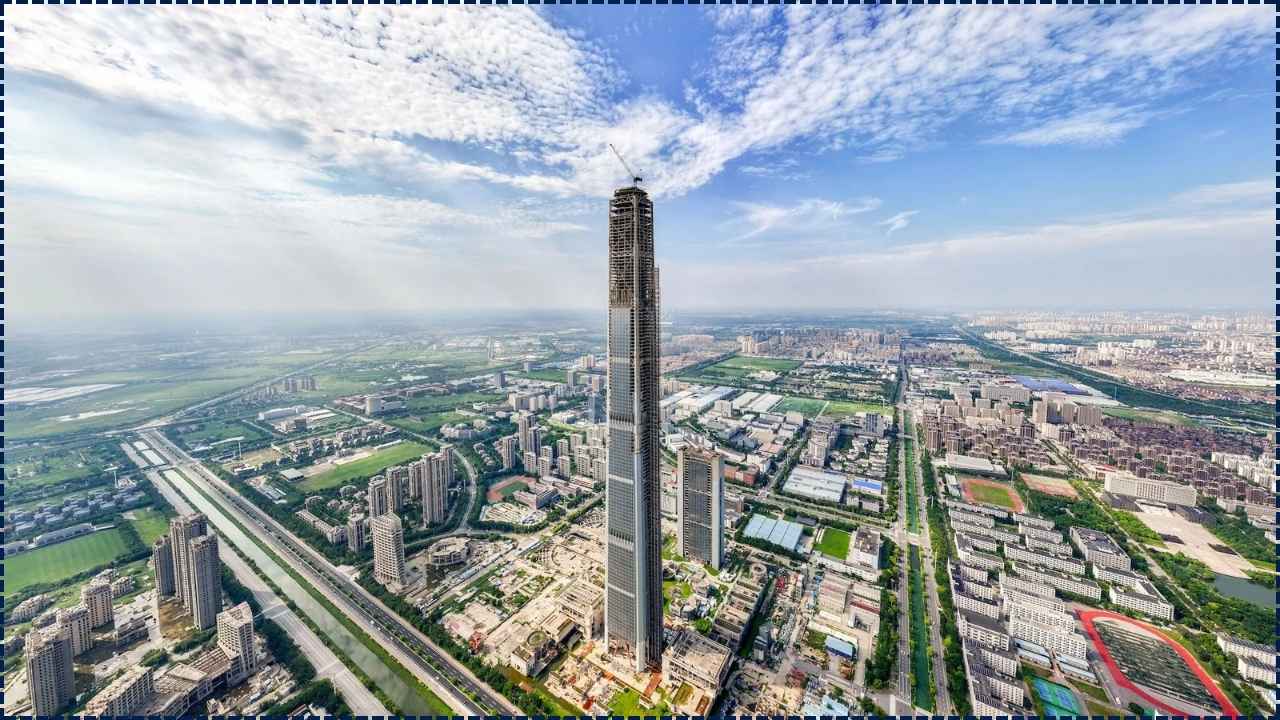World’s Tallest Abandoned Skyscraper Rises Again: Once seen as a ghost of failed ambition towering over Tianjin, China, the Goldin Finance 117 Tower, also nicknamed “The Walking Stick,” is rising again — literally and symbolically. After nearly a decade of abandonment, this colossal skyscraper is finally getting a second chance, and the reasons behind its revival are as unexpected as they are significant. With construction now officially resumed, the building is poised to complete what it once promised: to become an architectural and economic marvel.

Standing at a jaw-dropping 597 meters (1,959 feet) with 128 floors, the Goldin Tower was originally meant to showcase modern China’s prosperity during the real estate boom. Instead, it became a hollow monument to overambition when construction came to a halt in 2015. Now, in 2025, the structure is being resurrected — this time with a new vision, fresh financial backing, and a broader purpose that goes beyond height and luxury.
World’s Tallest Abandoned Skyscraper Rises Again
| Feature | Details |
|---|---|
| Building Name | Goldin Finance 117 Tower |
| Height | 597 meters (1,959 ft) |
| Floors | 128 |
| Status | Construction resumed in 2025; targeted completion: 2027 |
| Location | Tianjin, China |
| Previous Developer | Goldin Properties Holdings (now defunct) |
| Current Ownership | Undisclosed; believed to be state-backed consortium |
| New Function | Mixed-use: offices, residential, commercial, observation deck |
| Notable Design Feature | Transparent swimming pool in the diamond-shaped atrium |
| Sources | Architectural Digest, Wikipedia, Popular Science |
Once a towering reminder of what went wrong in China’s real estate frenzy, the Goldin Finance 117 Tower is turning a corner. With construction back in full swing, fresh financing, and updated goals, this project is more than just a comeback — it’s a symbol of adaptation, resilience, and bold thinking.
Whether you’re an architect, city planner, or someone fascinated by modern engineering feats, this story shows that even the tallest setbacks can turn into milestones — if you’re willing to finish what you started.
The Past That Haunts — Why Was Goldin Tower Abandoned?
The story begins in 2008, when China’s booming economy and demand for modern infrastructure led to an explosion of mega real estate projects. The Goldin Finance 117 Tower was envisioned as a high-end superstructure, combining a luxury hotel, elite residences, office space, and a sky-high shopping experience.
However, in 2015, the project screeched to a halt. The reasons? A perfect storm of economic setbacks:
- The Chinese stock market crash shattered investor confidence.
- The real estate bubble burst in several cities, including Tianjin.
- Its developer, Goldin Properties Holdings, went into liquidation.
Although the building’s exterior was nearly finished, the inside remained a hollow shell — unused, unloved, and undeniably iconic for the wrong reasons. It even earned a Guinness World Record as the tallest unoccupied building in the world.
Why Now? What’s Driving the Tower’s Comeback?
A few factors converged to spark the unexpected resurrection:
A Real Estate Reset
Following high-profile bankruptcies like Evergrande, the Chinese government prioritized economic stabilization by finishing previously abandoned or delayed construction projects. This helped regain public trust and attract foreign investment back to the market.
Boosting Confidence and National Image
Reviving Goldin Finance 117 is more than an engineering task. It’s about sending a clear message — that China is correcting course and its real estate ambitions are not dead, just being redefined.
New Players at the Helm
While the government has not confirmed the exact identity of the new financiers, several reports suggest a state-backed investment consortium is now in control. The building permit issued in April 2025 no longer references Goldin Properties, cementing the ownership change.
What Will the New Goldin Tower Become?
Though final plans are still under wraps, early renderings and insider leaks suggest:
- Office Spaces: Equipped with state-of-the-art workspaces for international firms and Chinese tech giants
- Luxury Residences: Smart condos with breathtaking views and premium amenities
- Observation Deck: A panoramic 360° deck for tourists, complete with an immersive experience and cafe
- Hospitality: Possibility of a boutique luxury hotel and wellness spa
- Leisure and Retail: From an indoor shopping mall to an art gallery and high-end restaurants
One standout feature is a transparent rooftop swimming pool set inside the tower’s iconic diamond-shaped atrium. It’s both an engineering marvel and a thrill-seeker’s dream.
The Big Picture — Why This Tower Matters Now More Than Ever
This isn’t just about finishing a tall building. Here’s why Goldin 117’s makeover is important:
Symbolic of Economic Recovery
If a project this big and long-abandoned can rise again, so can investor confidence in China’s construction sector.
Urban Revitalization
Tianjin has struggled to live up to its promise as a “megacity.” A completed landmark like this could reinvigorate tourism, local employment, and infrastructure development.
Global Case Study
Real estate analysts around the world are watching closely. This tower could become a textbook example of how to rescue stranded real estate investments and adapt to new urban planning needs.
Sustainability Focus
While unconfirmed, there are whispers that the new tower design may incorporate green building standards — including rainwater recycling, energy-efficient HVAC systems, and vertical gardens.
Lessons for Developers, Investors, and Governments
The Goldin Tower revival offers some hard-won lessons:
Always Align Supply With Demand
Too many Chinese cities built ultra-modern spaces without tenants. Future developments need a better ground-up demand analysis.
Build Multi-Purpose
Today’s best skyscrapers are more than tall buildings — they’re mini-cities. Blending business, leisure, housing, and retail under one roof is key.
Future-Proof the Finances
Real estate markets are cyclical. Projects of this scale should plan for economic downturns and secure phased funding.
Public-Private Collaboration
The resurgence of Goldin 117 may only be possible due to strategic government involvement — showing that P3 models can work when private capital falls short.
FAQs On World’s Tallest Abandoned Skyscraper Rises Again
Q1: What was the original purpose of the Goldin Finance 117 Tower?
A: It was designed as a luxury mixed-use skyscraper featuring a hotel, high-end offices, and apartments.
Q2: Why was the project abandoned?
A: Construction stopped in 2015 due to a combination of financial trouble from the developer and China’s economic downturn.
Q3: When is it expected to be completed?
A: Construction restarted in April 2025 and is projected to finish by mid-to-late 2027.
Q4: Will it be the tallest building in China?
A: It will be the third-tallest, behind the Shanghai Tower and Ping An Finance Center.
Q5: Who is funding the new construction?
A: The project appears to be backed by a government-linked consortium, though official confirmation is pending.







